The electric motor is today’s most common mechanical power source in modern industrial manufacturing environments. But does that mean that it is the best or safest choice for all applications? The answer is no.
Industry 4.0 brought digitalization and electrification to manufacturing processes and assembly tools. Electric motors offer remarkable energy efficiency and greater operational freedom for factory floor operators. With the development of battery technology, even the power cord is a thing of the past.
But despite these advantages, there are industrial manufacturing environments and applications where the electric motor is simply not the best choice. And here, the good old air motor, powered by compressed air, can make all the difference.
Over the past two centuries, industrial manufacturers have relied on air motors to power handheld and fixture tools. Years of improvements and developments have enabled air motors to deliver unparalleled safety, operational, and cost benefits.
- Safety is always a top priority in industrial manufacturing environments. In delicate manufacturing settings, air motors avoid overheating and spark production, greatly reducing fire and explosion risks.
- Air motors offer a power-to-weight ratio that is 2-3 times higher than that of electric motors and can operate in any position, making them the perfect alternative for applications that require both flexibility and power.
- An air motor does not heat up or degrade, even at high cycle rates. Unlike electric and battery tools that require heat monitoring to prevent damage, air motors ensure constant, reliable operation through cooling via air expansion.
- With comparable lower installation and maintenance costs the air motor increases manufacturing productivity and reduces total cost of ownership.
Learn more about the Atlas Copco air motors and electric motors to choose the right product for your needs.


